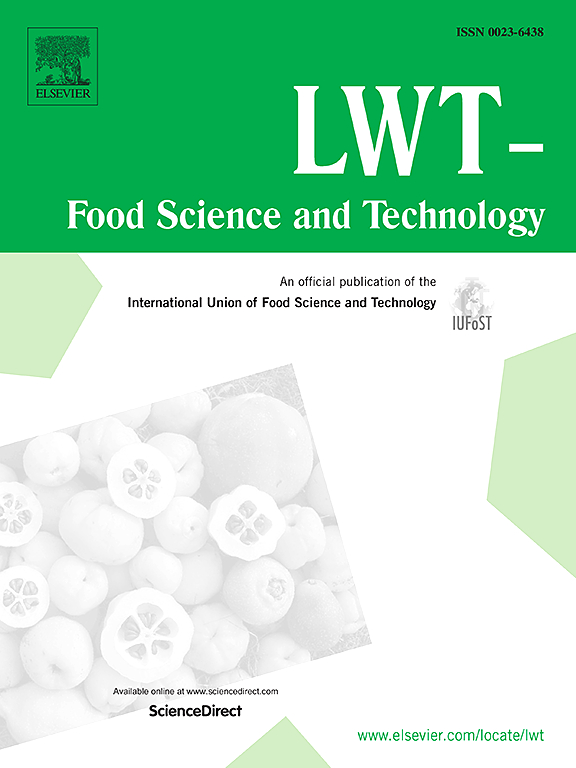Methionine as a novel co-pigment for color stabilization in Dendrobium officinale flower juice: Mechanisms and applications
IF 6
1区 农林科学
Q1 FOOD SCIENCE & TECHNOLOGY
引用次数: 0
Abstract
This study systematically evaluated eight amino acids and five organic acids as co-pigments to enhance the color stability of Dendrobium officinale flower juice (DOFJ). Comparative evaluation revealed L-methionine (Met) and caffeic acid as the most effective color stabilizers. At their respective optimal concentrations, Met (0.8 % w/v) demonstrated superior performance than caffeic acid (the anthocyanin-to-caffeic acid ratio of 1:180), significantly reducing color degradation (ΔE < 3.5 after 10 days at 25 °C) and improving anthocyanin retention (50.6 %). Dendrobium officinale flower anthocyanins (DOFA) characterization identified cyanidin-3-O-(6-O-malonyl-glucoside) (47.9 %) and cyanidin-3-O-glucoside (15.3 %) as the major anthocyanins. FT-IR and XRD confirmed hydrogen bonding between Met and DOFA. In addition, differential scanning calorimetry revealed that the incorporation of Met enhanced the thermal stability of DOFA, likely due to the intermolecular interactions between the two components. Molecular docking further demonstrated that the increased stability of Met-DOFA couplings could be attributed to their intermolecular interactions, mainly through hydrogen bonding. Importantly, electronic nose and GC-MS analyses showed that the addition of Met did not adversely affect DOFJ and that the major flavor compounds remained aldehydes, alcohols and alkenes. These results demonstrated Met functionality as a color stabilizer.
蛋氨酸作为铁皮石斛花汁颜色稳定的新型共色素:机制与应用
本研究系统评价了8种氨基酸和5种有机酸作为共色素对铁皮石斛花汁(DOFJ)颜色稳定性的影响。比较评价表明l -蛋氨酸和咖啡酸是最有效的颜色稳定剂。在各自的最佳浓度下,蛋氨酸(0.8% w/v)表现出优于咖啡酸(花青素与咖啡酸的比例为1:180)的性能,显著降低了颜色降解(ΔE <;25°C保存10天后(3.5),提高花青素保留率(50.6%)。石斛花花青素(DOFA)鉴定主要为花青素-3- o -(6- o -丙二醇-葡萄糖苷)(47.9%)和花青素-3- o -葡萄糖苷(15.3%)。FT-IR和XRD证实了Met和DOFA之间的氢键。此外,差示扫描量热法显示,Met的掺入增强了DOFA的热稳定性,这可能是由于两种成分之间的分子间相互作用。分子对接进一步证明Met-DOFA偶联稳定性的提高可能归因于它们的分子间相互作用,主要是通过氢键。重要的是,电子鼻和GC-MS分析表明,添加Met对DOFJ没有不利影响,主要的风味化合物仍然是醛类、醇类和烯烃类。这些结果证明了Met作为颜色稳定剂的功能。
本文章由计算机程序翻译,如有差异,请以英文原文为准。
求助全文
约1分钟内获得全文
求助全文
来源期刊

LWT - Food Science and Technology
工程技术-食品科技
CiteScore
11.80
自引率
6.70%
发文量
1724
审稿时长
65 days
期刊介绍:
LWT - Food Science and Technology is an international journal that publishes innovative papers in the fields of food chemistry, biochemistry, microbiology, technology and nutrition. The work described should be innovative either in the approach or in the methods used. The significance of the results either for the science community or for the food industry must also be specified. Contributions written in English are welcomed in the form of review articles, short reviews, research papers, and research notes. Papers featuring animal trials and cell cultures are outside the scope of the journal and will not be considered for publication.
 求助内容:
求助内容: 应助结果提醒方式:
应助结果提醒方式:


